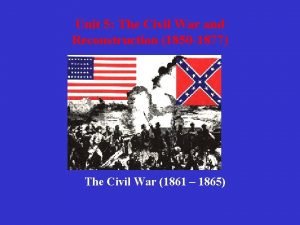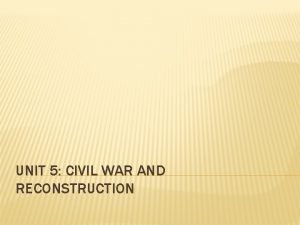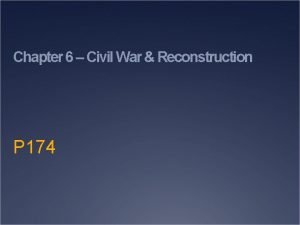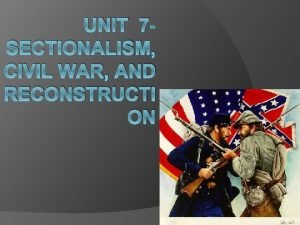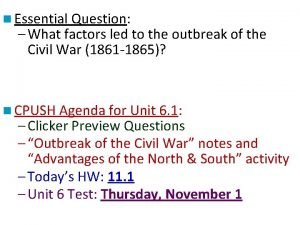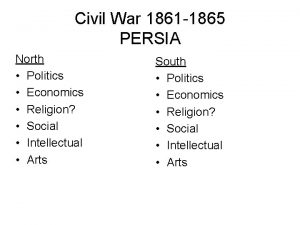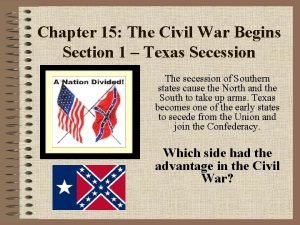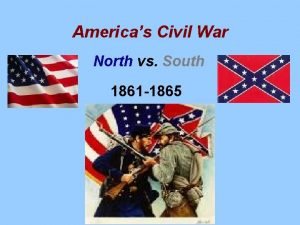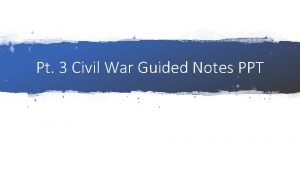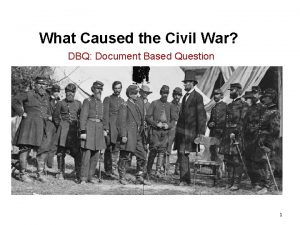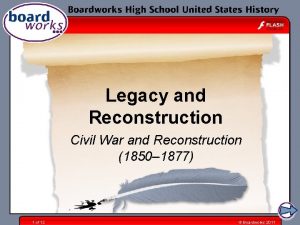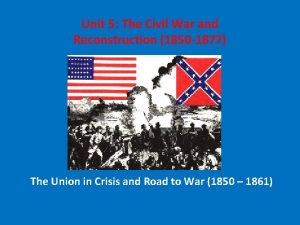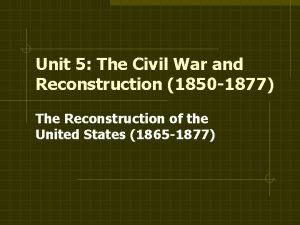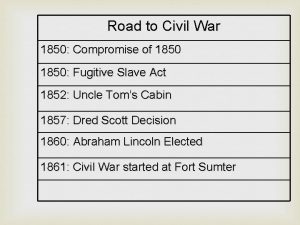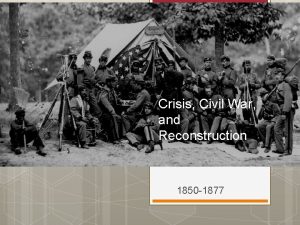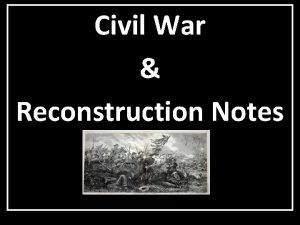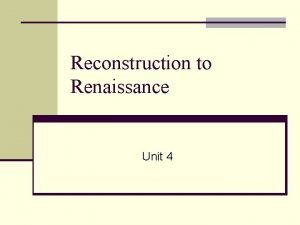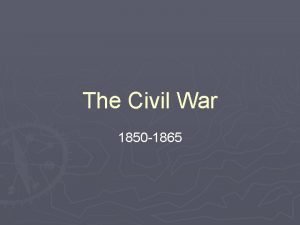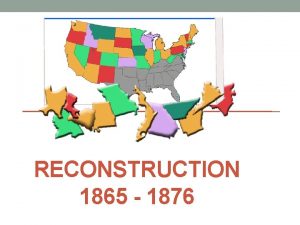Unit 5 The Civil War and Reconstruction 1850
















- Slides: 16

Unit 5: The Civil War and Reconstruction (1850 -1877) The Civil War (1861 – 1865)

Daily Learning Targets • I can identify and analyze the technological, social, and strategic aspects of the Civil War. • I can analyze the influence of President Lincoln’s philosophy of union on the course of the Civil War.

Exit Slip: The Union in Crisis 1. A strong fugitive slave law and California’s admission to the Union as a free state were all part of the a. Missouri Compromise. b. Compromise of 1850. c. Wilmot Proviso. d. Wade-Davis Bill. 2. Uncle Tom's Cabin (1852) convinced many Northerners that a. slaves lived better than factory workers. b. slavery was a necessary evil. c. slavery was cruel and morally wrong. d. slaves were generally happy in bondage. 3. “Bleeding Kansas” earned its nickname from clashes over a. the Gadsden Purchase. c. slavery. b. religious differences. d. land ownership. 4. Why was abolitionist John Brown executed in 1859? a. for attempting to seize an arsenal at Harper’s Ferry and start a slave rebellion b. for killing hundreds of Native Americans on a western reservation c. for beating Senator Charles Sumner with a cane d. for causing violence and bloodshed in the Kansas territory

Secession! South Carolina is first to leave on Dec. 20, 1860. Six others follow to CSA by 1861. Eventually 11 total in CSA.

Lincoln Takes Office • March 4, 1861 – Republican President Lincoln took a firm, but kind & conciliatory tone toward the South. • He didn’t want to bother slavery where it was, but he did want to stop it from spreading into the Western territories. • He pledged to preserve the Union - #1 Goal!

Southern War Strategy • After Confederate forces attacked & captured Fort Sumter in Charleston, SC (April 12, 1861) 4 more states joined the CSA. • President Lincoln declared that war would be necessary to achieve his #1 goal! So he decided to resupply Fort Sumter. • The CSA Generals and President Jefferson Davis planned a defensive war as they just had to outlast the Union not conquer the North. • CSA hoped Great Britain and/or France would help and had superior military leadership.

Northern War Strategy • The Union developed a strategy called the Anaconda Plan. They hoped to: 1. Use strong Navy to Blockade all Southern Ports 2. Control the Mississippi River and divide the CSA in two 3. Capture and occupy the Confederate capital of Richmond, VA

Stalemate: From Bull Run to Antietam • July 21, 1861 – “Stonewall” Jackson rallies CSA at Bull Run, VA – a CSA victory. Both sides realized it would be a long war. • CSA General R. E. Lee, America’s greatest general, achieved a draw at the Battle of Antietam, MD. 25, 000 died on Sept. 17, 1862 making it the bloodiest day of the war. • The CSA won a string of stunning and impressive victories against the superior Union army & Lincoln spent the first years looking for leadership. • In spite of Union victories at Shiloh, TN, Perryville, KY, New Orleans, LA, and the lower Mississippi Valley, at the end of 1862, a stalemate existed in the East.

The Emancipation Proclamation • Issued in the Fall 1862 and effective Jan. 1, 1863 • Freed all slaves in areas of the U. S. still under CSA control • Although it was criticized by some, it meant the war would end slavery if Union indeed won. • Lincoln changed his wartime strategy. • Eventually 180, 000 African Americans would serve in the Union Army.

The Impact of the War in the North and South • Mines, factories, railroad, and weapons production soared. • The government encouraged Western settlement for soldiers who would give two years of service in return for land. This boosted food production. • New York Draft Riots (1863) and similar protests occurred in the North in opposition to compulsive military service for men 20 -45. Free blacks and wealthy whites were targeted. Why? • Lincoln suspended the Constitutional right of Habeas Corpus that protects persons from imprisonment without the filing of specific charges and many arrested for suspected disloyalty. • In the South, property was devastated and the economy was wrecked by inflation – price increases due to concern about the value of Confederate money.

1863: The Turning Point • July 1 -3, 1863 – Lee leads his Army of N. VA North to PA and the greatest battle of the war begins. • 23, 000 Union and 28, 000 CSA casualties at Gettysburg, PA. Lee’s only major mistake of the war was Picket’s Charge on Day 3. • Lee would never invade Union again! • July 4, 1863 – General Ulysses S. Grant, the Unions most successful commander, captures Vicksburg on Mississippi River. • By early 1864 Grant is chosen by Lincoln to take command of the Union Army.

Sherman’s March to the Sea and Total War • Sept. 2, 1864 – Gen. Sherman captures Atlanta, GA • Marches to Savannah, GA and orders a 300 mile-long and 50 mile-wide swath of destruction designed to end the CSA’s will & ability to fight. • Turns north through Carolinas in Dec. 1864 to meet Grant & end war • Civilians and slaves suffer immensely; it was controversial.

The Election of 1864 • The capture of Atlanta and “Bayonet Voters” aid Lincoln’s re-election hopes. • He was opposed by Democrat and ex-General George Mc. Clellan – a peace candidate who wanted to end the war • Lincoln and Andrew Johnson (VP and Democrat) form the Union Party and win 212/233 electoral votes

Lee Surrenders to Grant! April 9, 1865 • Richmond, the CSA capital, was in ruins, Sherman wasted Georgia and the Carolinas, & Lee’s army was desperate & worn down. • President Davis and officials fled from Grant & later captured • Lee was humble and Grant was very generous at Appomattox, VA • 640, 047 Union and 483, 026 CSA casualties of war; America’s bloodiest war in history.

Exit Slip – The Civil War Begins 1. Which side planned a defensive war? a. Union b. Confederacy c. Mexico 2. At the end of 1862 _____. a. the Union was winning b. the Confederacy was winning c. both sides were locked in a stalemate 3. This act by President Lincoln freed all slaves in states of the Confederacy not under Union rule? a. Emancipation Proclamation b. 3/5 Compromise c. 13 th Amendment d. Homestead Act

Exit Slip – The Civil War 1. Who was the commander of all Confederate forces after 1862? a. Longstreet b. Bragg c. Lee 2. This battle of July 1863 was turning point of the Civil War? a. Antietam b. Gettysburg c. Chickamauga 3. This city was totally destroyed during Sherman’s March? a. Atlanta b. Savannah c. Charleston 4. Which side won the Civil War? a. Union b. Confederacy c. It was a draw
 Unit 4 civil war and reconstruction
Unit 4 civil war and reconstruction Unit 5 civil war and reconstruction
Unit 5 civil war and reconstruction Reconstruction vocabulary words
Reconstruction vocabulary words Civil war and reconstruction study guide
Civil war and reconstruction study guide Chapter 6 civil war and reconstruction
Chapter 6 civil war and reconstruction Civil war and reconstruction achieve 3000 answer key
Civil war and reconstruction achieve 3000 answer key Toward civil war lesson 3 secession and war
Toward civil war lesson 3 secession and war Civil war first modern war
Civil war first modern war Civil rights webquest
Civil rights webquest Cotton diplomacy
Cotton diplomacy Civil war advantages and disadvantages chart
Civil war advantages and disadvantages chart States rights
States rights North and south states civil war
North and south states civil war Us north vs south
Us north vs south Civil war ppt and guided notes
Civil war ppt and guided notes Guernica
Guernica Causes of the civil war dbq
Causes of the civil war dbq

